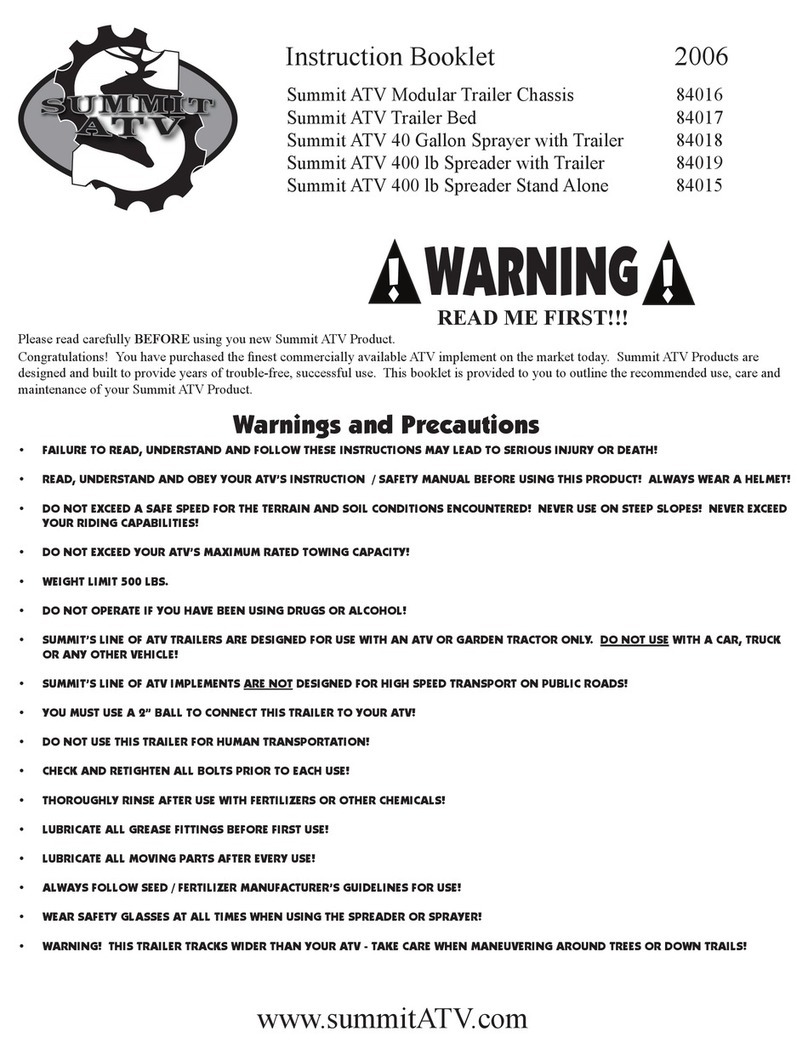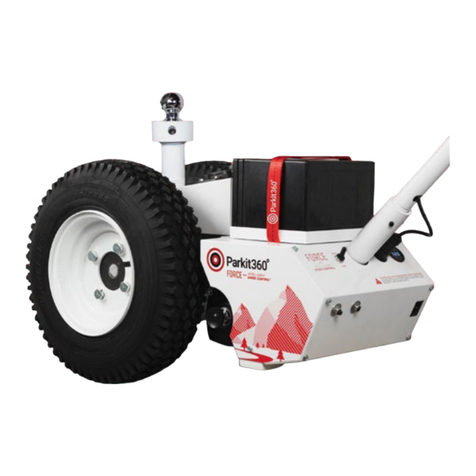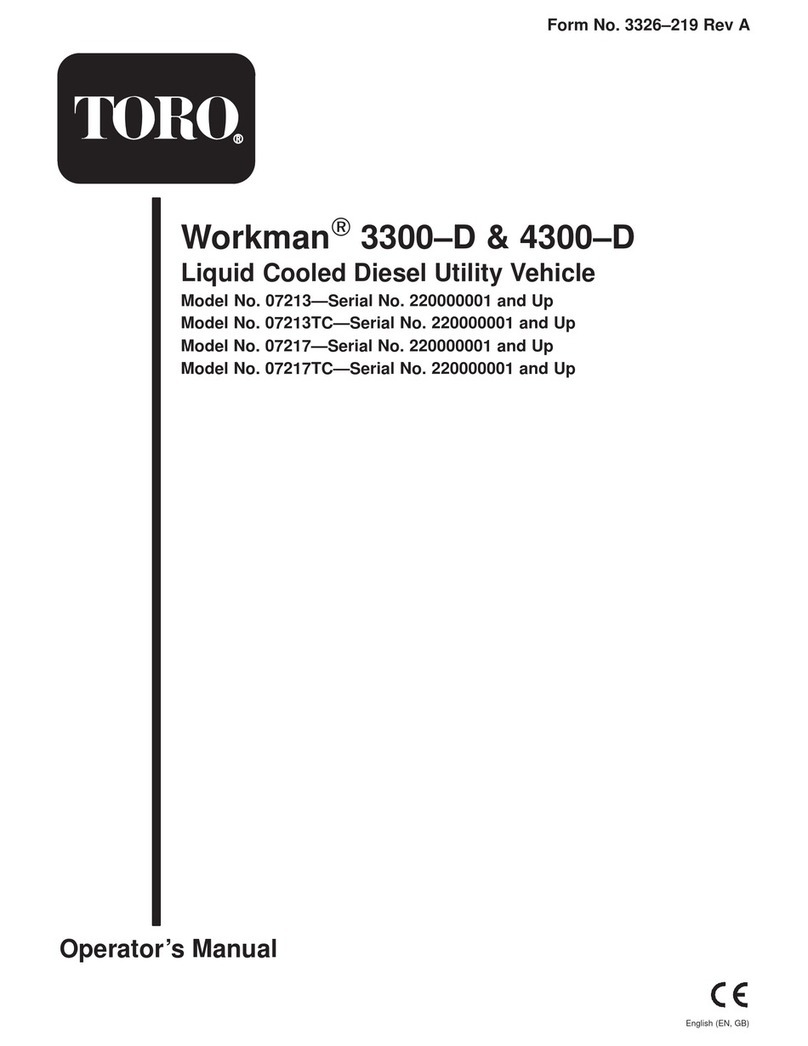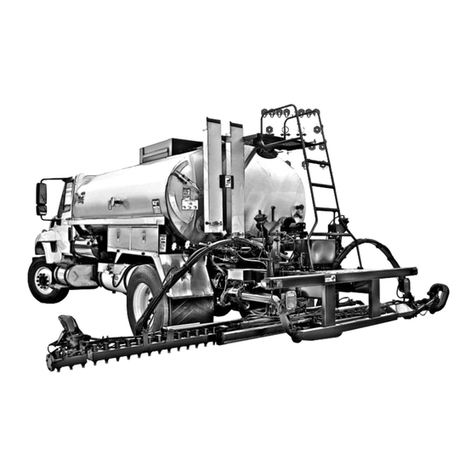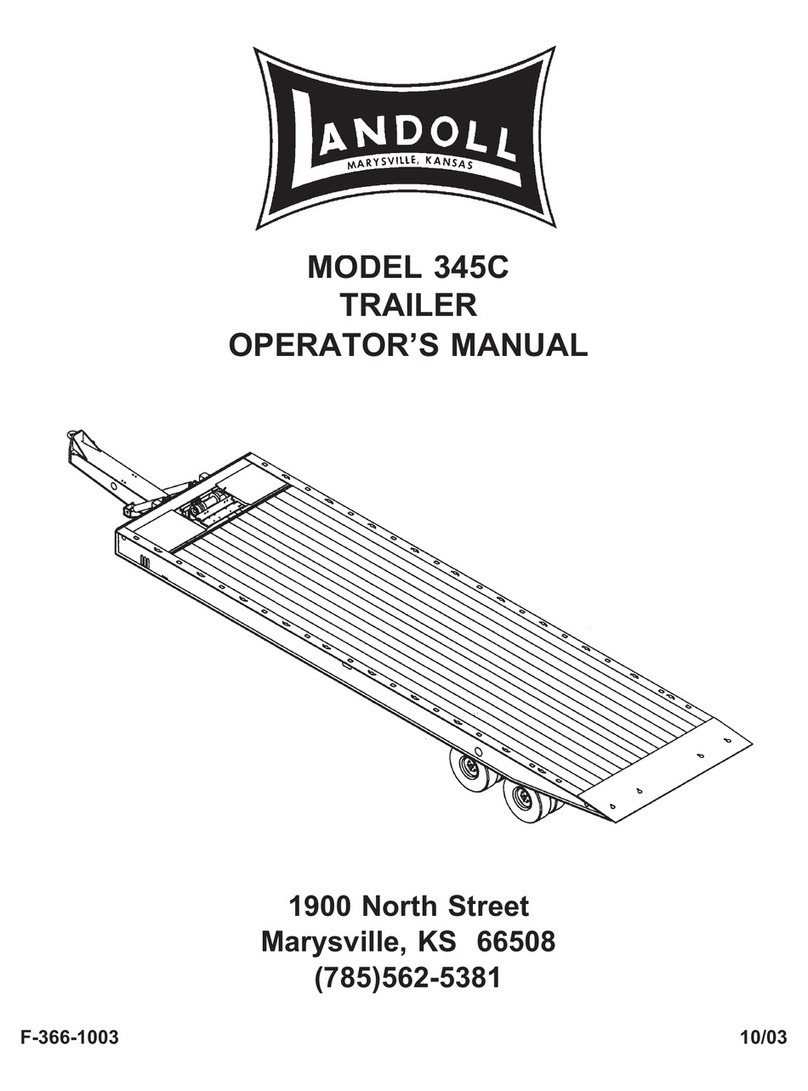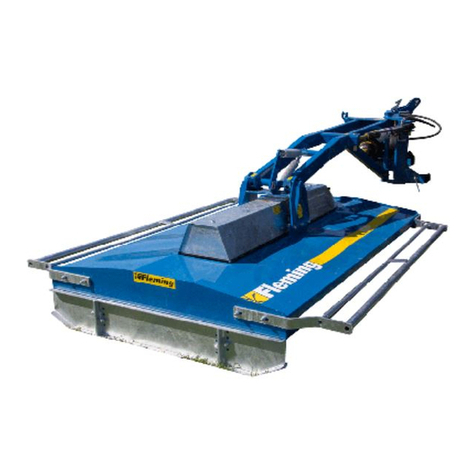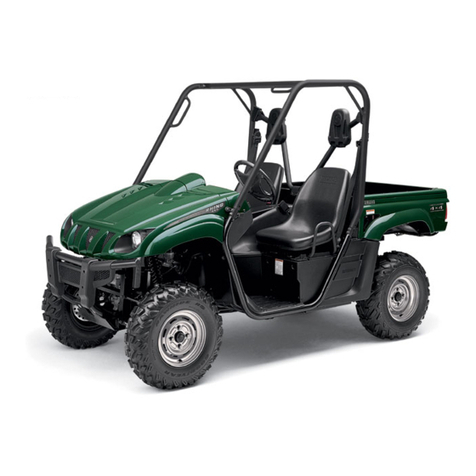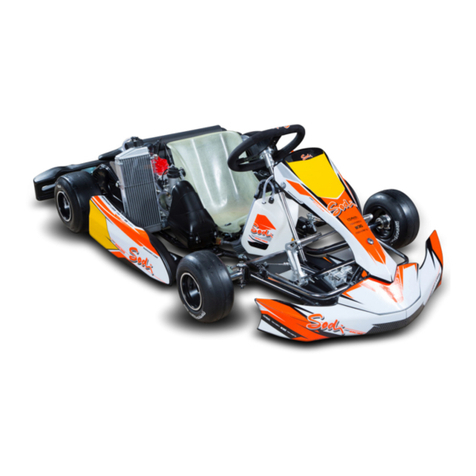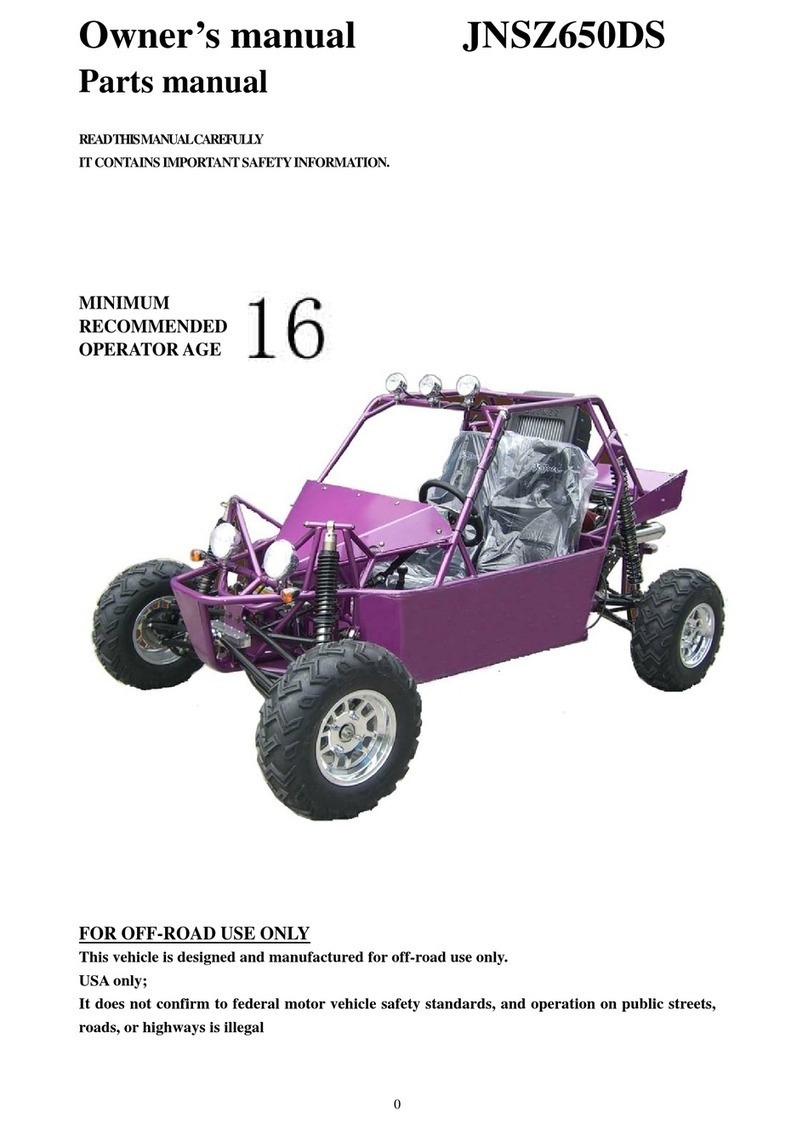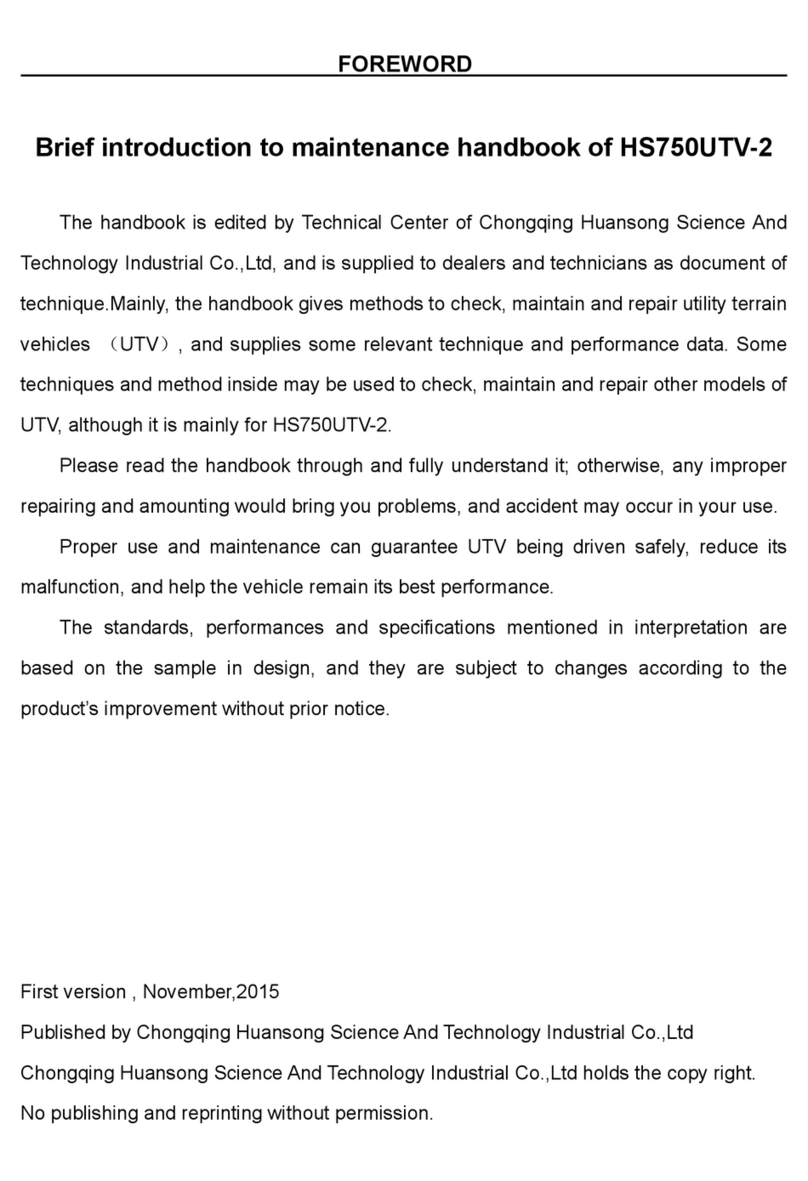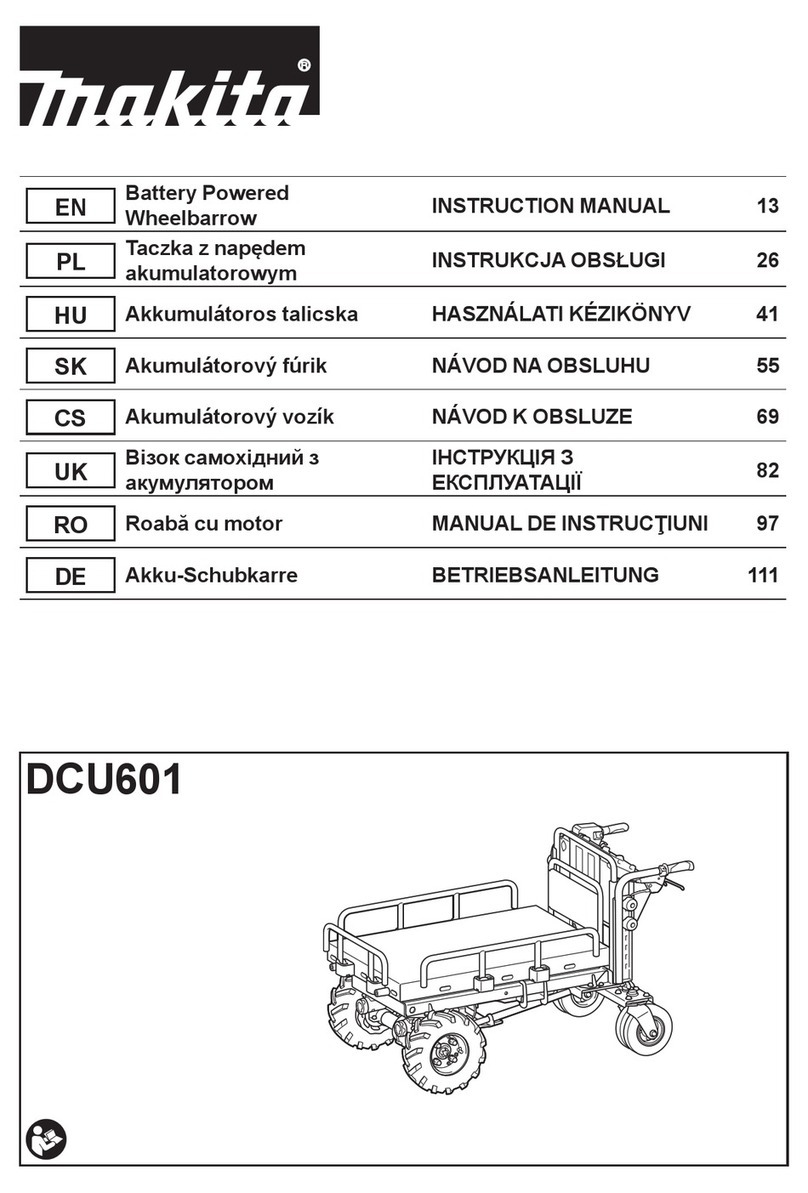Gradall LOED 534A User manual

LOED MATERIAL HANDLER
MODEL 534A
Service Manual
PART NO. 9020-5896
®
IMPORTANT
READ AND UNDERSTAND THIS MANUAL
BEFORE STARTING, OPERATING OR
PERFORMING MAINTENANCE PROCEDURES
ON THIS MACHINE.
KEEP THESE MANUAL IN CAB
Gradall is a registered trademark for hudraulic
excavators built by The Gradall Co.
THE
COMPANY
406 MILL AVENUE S.W.
NEW PHILADELPHIA, OHIO 44663
(216) 339-2211
This manual describes the LOED Handler as origionally
designed and built by the LOED Corporation. The LOED
Handler product line was purchased October 15, 1982 by
The Warner & Swasey Co., a subsidiary of The Bendix
Corporation. Descriptions and specifications shown herein
are subject to change without notice.

CONTENTS
Service/replacement parts . . . . . . . . . . . . . . . . . . . . . . . . . . . . . . . . . . . . . . . . . . . . . . . . . . . . . . . . . . . . .
Capacity . . . . . . . . . . . . . . . . . . . . . . . . . . . . . . . . . . . . . . . . . . . . . . . . . . . . . . . . . . . . . . . . . . . . . . .
Nomenclature . . . . . . . . . . . . . . . . . . . . . . . . . . . . . . . . . . . . . . . . . . . . . . . . . . . . . . . . . . . . . . . . . . . .
Retraction chain replacement . . . . . . . . . . . . . . . . . . . . . . . . . . . . . . . . . . . . . . . . . . . . . . . . . . . . . . . . . . .
Extension chain replacement . . . . . . . . . . . . . . . . . . . . . . . . . . . . . . . . . . . . . . . . . . . . . . . . . . . . . . . . . . .
Boom hose replacement . . . . . . . . . . . . . . . . . . . . . . . . . . . . . . . . . . . . . . . . . . . . . . . . . . . . . . . . . . . . . .
Shift control adjustment . . . . . . . . . . . . . . . . . . . . . . . . . . . . . . . . . . . . . . . . . . . . . . . . . . . . . . . . . . . . . .
Brake adjustment . . . . . . . . . . . . . . . . . . . . . . . . . . . . . . . . . . . . . . . . . . . . . . . . . . . . . . . . . . . . . . . . . .
Tire and rim repair . . . . . . . . . . . . . . . . . . . . . . . . . . . . . . . . . . . . . . . . . . . . . . . . . . . . . . . . . . . . . . . . . .
Parking brake repair . . . . . . . . . . . . . . . . . . . . . . . . . . . . . . . . . . . . . . . . . . . . . . . . . . . . . . . . . . . . . . . . .
Power master cylinder repair . . . . . . . . . . . . . . . . . . . . . . . . . . . . . . . . . . . . . . . . . . . . . . . . . . . . . . . . . . . .
Planetary hub repair . . . . . . . . . . . . . . . . . . . . . . . . . . . . . . . . . . . . . . . . . . . . . . . . . . . . . . . . . . . . . . . . .
Hydraulic pressure adjustment . . . . . . . . . . . . . . . . . . . . . . . . . . . . . . . . . . . . . . . . . . . . . . . . . . . . . . . . . .
Hydraulic cylinder repair . . . . . . . . . . . . . . . . . . . . . . . . . . . . . . . . . . . . . . . . . . . . . . . . . . . . . . . . . . . . . .
Valve repair . . . . . . . . . . . . . . . . . . . . . . . . . . . . . . . . . . . . . . . . . . . . . . . . . . . . . . . . . . . . . . . . . . . . . .
Pump and motor troubleshooting . . . . . . . . . . . . . . . . . . . . . . . . . . . . . . . . . . . . . . . . . . . . . . . . . . . . . . . . .
Pump repair . . . . . . . . . . . . . . . . . . . . . . . . . . . . . . . . . . . . . . . . . . . . . . . . . . . . . . . . . . . . . . . . . . . . . .
Rear motor repair . . . . . . . . . . . . . . . . . . . . . . . . . . . . . . . . . . . . . . . . . . . . . . . . . . . . . . . . . . . . . . . . . .
Front motor repair . . . . . . . . . . . . . . . . . . . . . . . . . . . . . . . . . . . . . . . . . . . . . . . . . . . . . . . . . . . . . . . . . .
Bolt torque chart . . . . . . . . . . . . . . . . . . . . . . . . . . . . . . . . . . . . . . . . . . . . . . . . . . . . . . . . . . . . . . . . . . .
Hydraulic fitting torque chart . . . . . . . . . . . . . . . . . . . . . . . . . . . . . . . . . . . . . . . . . . . . . . . . . . . . . . . . . . .
Electrical schematic . . . . . . . . . . . . . . . . . . . . . . . . . . . . . . . . . . . . . . . . . . . . . . . . . . . . . . . . . . . . . . . . .
Hydraulic schematic . . . . . . . . . . . . . . . . . . . . . . . . . . . . . . . . . . . . . . . . . . . . . . . . . . . . . . . . . . . . . . . .
Hydraulic component location . . . . . . . . . . . . . . . . . . . . . . . . . . . . . . . . . . . . . . . . . . . . . . . . . . . . . . . . . . .
Parts section - contents . . . . . . . . . . . . . . . . . . . . . . . . . . . . . . . . . . . . . . . . . . . . . . . . . . . . . . . . . . . . . .
3
4
5
6
8
10
11
12
13
18
20
24
29
30
32
44
45
55
74
84
85
86
89
93
95
1

GENERAL INFORMATION
IMPORTANT SAFETY NOTICE
Safe operation depends on reliable equipment and proper operating
procedures. Performing the checks and services described in this manual will
help to keep your Gradall Handler in reliable condition and use of the
recommended operating procedures can help you avoid accidents. Because
someproceduresmaybe newto eventhe experiencedoperator werecommend
that this manual be read, understood and followed by all who operate the unit.
Danger, Warning and Caution notes in this manual will help you avoid injury
and damage to the equipment. These notes are not intended to cover all
eventualities; it would be impossible to anticipate and evaluate all possible
applicationsandmethodsofoperationforthisequipment.
Anyprocedurenotspecifically recommended by TheGradallDivisionmust be
thoroughly evaluated from the standpoint of safety before it is placed in
practice. If you aren’t sure, contact your Gradall Distributor before operating.
Do not modify this machine without written permission from the Gradall
Division.
NOTICE
The Gradall Division retains all
proprietary rights to the information
contained in this manual.
TheCompanyalsoreservestherightto
change specifications without notice.
MODEL 534A LOED HANDLER
2

SERVICE
Your LOED Handler distributor is properly equipped to service your LOED Handler.
Repairs should be made by trained and qualified service personnel only.
Modifications must not be made unless prior approval has been obtained from LOED
Corporation. Your distributor has the necessary forms to request authorization
for specific modifications.
REPLACEMENTPARTS
Replacement parts can be ordered from your nearest LOED Handler distributor.
Always furnish the machine model and serial number as well as a complete description
of the part and the part number. This enables the distributor to quickly and
accurately fill your order.
NOTE: For a safer more dependable machine, use only factory approved parts.
CAUTION: Do not attempt to
repair your machine unless
you are trained and qualified
to do so.
CAUTION: Do not modify your
prior approval of LOED Corpora-
tion. The safety and reliability
of your machine may be affected
by improper modification.
3

MODEL 534
6,000# Capacity
4
FIGURE 1

NOMENCLATURE
5
FORKS
FORKFRAME
BOOMHEAD
TILTCYLINDER
THREESECTIONBOOM
LIFTCYLINDER
COMPENSATINGCYLINDER
HYDRAULICRESERVOIR
FUELTANK
PLANETARYHUB
CROWDCYLINDER
LEVELCYLINDER
1.
2.
3.
4.
5.
6.
7.
8.
9.
10.
11.
12.
FIGURE 2

RETRACTION CHAIN REPLACEMENT
DISSASSEMBLY
Retract boom completely.
Remove rear boom cover.
Remove extension (large) chain adjusting nut and jam nut.
Remove hose retainer nuts and jam nuts. Disconnect hoses.
Remove bolts holding hose guide pan to front of strongback.
Remove strongback.
Unpin retraction (small) chain from chain ears at back of third
section.
Unpin retraction chain from section one ears (access hole in
bottom of section).
Pull chain out back of boom.
REASSEMBLY
Note: Replace chain ends whenever chain is replaced.
Use fish wire to pull new chain from back of boom to ears in
bottom of section one.
Lay chain over sheave and pin to back of section three.
Reinstall strongback. Use LOCTITE 242 (blue-medium strength)
on all bolts and torque to specification.
Bolt hoseguide pan to strongback.
Reconnect extension chain. With crowd cylinder fully retracted,
tighten extension chain until there is no slack in retracting
chain. Install jam nut.
Reconnect hoses and hose retainers.
Reinstall rear boom cover.
6
1.
2.
3.
4.
5.
6.
7.
8.
9.
1.
2.
3.
4.
5.
6.
7.

7
Guide Pan
Strongback
Hose Retainer Nuts
Extension Chain Nuts
Section One
Section Two
Take-up Beam
Take-up Beam Bracket
Section Three
Retraction Chain
Section Three Chain Ears
Extension Chain
1.
2.
3.
4.
5.
6.
7.
8.
9.
10.
11.
12.
FIGURE 3

EXTENSIONCHAIN REPLACEMENT
DISSASSEMBLY
Retract boom completely.
Remove rear boom cover.
Remove extension (large) chain adjusting and jam nuts.
Remove hose retainer and jam nuts. Disconnect hoses.
Remove bolts holding hose guide pan to front of strongback.
Remove strongback.
Unpin retraction (small) chain from chain ears at back of third section.
Allow chain to lie on bottom of 1st section.
Unbolt take-up beam bracket from back of section two. Pull beam and
hose guide pan out back of boom.
Unpin extension chain from ears at back of section three.
REASSEMBLY
Note: Replace chain ends whenever chain is replaced
Pin extension chain to ears at back of section three.
Lay chain and hoses in hose guide pan.
Carefully slide take-up beam and guide pan into boom allowing chain
and hoses to roll over sheaves at front of beam.
Bolt take-up beam bracket into back of section two.
Note: Use LOCTITE 242 (blue-medium strength) on all bolts and
torque to specification.
Pin retraction chain to ears on back of section three.
Reinstall strongback.
Bolt hose guide pan to strongback.
Reconnect extension chain. With crowd cylinder fully retracted,
tighten extension chain until there is no slack in retraction
chain.
Reconnect hoses and hose retainers.
Reinstall rear boom cover.
1.
2.
3.
4.
5.
6.
7.
8.
9.
1.
2.
3.
4.
5.
6.
7.
8.
9.
10.
8

Retraction Chain
Retraction Chain Ears - Section 1
Section Three
Retraction Chain Ears - Section 3
9
Guide Pan
Strongback
Hose Retainer Nuts
Extension Chain Nuts
Section One
1.
2.
3.
4.
5.
6.
7.
8.
9.
FIGURE 4

BOOMHOSE REPLACEMENT
IFHOSEISINTACT
Remove rear boom cover.
Disconnect hose retainer and remove tensioning spring.
Connect new hose to old hose with short length of steel wire.
Disconnect old hose at back of section three. Carefully pull
new hose along guide pan and around reel while pulling old hose
out back of boom.
Connect new hose to tube line at rear of section three.
Reassemble hose retainer and reinstall. Connect hose.
Replace rear boom cover.
IF HOSE IS BROKEN
Follow dissassembly procedure outlined in “Extension Chain Replacement”
through step 8. Replace hose and reassemble.
1.
2.
3.
4.
5.
6.
7.
10

SHIFTCONTROLLINKAGEADJUSTMENT
Put shift control in 1st gear.
Adjust valve linkage (A) so micro switch (B) is actuated
with spool pulled down to stop.
Adjust linkage (C) so movement of lever from 1-2 and 3-4
moves spool from full down to full up.
Adjust linkage (D) so spool moves from full back to full
forward as lever is moved from 2-3.
Repeat 1 thru 4 as necessary to get smooth shifting action.
1.
2.
3.
4.
5.
11
FIGURE 5

BRAKEADJUSTMENT
SERVICEBRAKE
Note: Prior to any brake adjustment the forward-reverse linkage
must be adjusted as follows:
With the forward-reverse lever in neutral, adjust
linkage rod “A” so that “B” to “B1” and “C” to “C1”
are of equal length, with the forward-reverse valve
spool in its neutral position (linkage rod “D” may
have to be adjusted to reach alignment).
With the forward-reverse lever in forward, depress
brake pedal until all slop is taken up in the brake
linkage. At that point the spool in the forward-
reverse valve should be 1/8" out of the neutral
position. If not, adjust brake linkage compression
spring “E” to reach that point.
PARKINGBRAKE
1.
2.
The spring-apply/hydraulic release brake requires
no adjustment.
On machines with mechanical brake calipers, adjust
both sides so the pads nearly touch the disc when
the lever is in the off position.
1.
2.
12
FIGURE 6

GENERAL:
Do not mount or demount tires without
proper training. Follow all procedures and
safety instructions. Wall charts containing
mounting and demounting instructions for
all Goodyear on-highway rims are avail-
able through your Goodyear rim supplier.
Ask for “ON-HIGHWAY RIM MOUNT-
ING AND DEMOUNTING CHART SET
NO. TR71-2042". This set contains five
charts covering all Goodyear on-highway
rims.
“MULTIPIECE RIM/WHEEL MATCH-
ING CHARTS” are available through
Motor Wheel Corporation and the United
States Department of Transportation
(DOT), Washington, D.C.
DEMOUNTING:
Always exhaust all air from a single tire
and from both tires of a dual assembly
prior to removing any rim components or
any wheel components such as nuts and
rim clamps.
Make sure to remove valve core to ex-
haust all air from the tire. Remove both
cores from a dual assembly.
Check the valve stem by running a piece of
wire through the stem to make sure it is
not plugged.
For safety’s sake, always remove the valve core and exhaust all air from a
single tire and from both tires of a dual assembly prior to removing any
rim components, or any wheel components, such as nuts and rim
clamps.
Check the valve stem by running a piece of wire through the stem to
make sure it Is not plugged
IMPORTANT
!
!
!
!
!
TIREandRIMSERVICINGSAFETY
INSPECTION:
Clean rims and repaint to stop detrimen-
tal effects of corrosion and facilitate
checking and tire mounting. Be very care-
ful to clean all dirt and rust from the lock
ring and gutter. This is important to
secure the lock ring in its proper position.
A filter on the air inflation equipment to
remove the moisture from the air line
helps prevent corrosion. The filter should
be checked periodically to see that it is
working properly.
Check rim components periodically for
cracks. Replace all cracked, badly worn,
damaged and severely rusted components
with new parts of same size and type.
When in doubt replace.
Do not, under any circumstances, attempt
to rework, weld, heat, or braze any rim
components that are cracked, broken, or
damaged. Replace with new parts or parts
that are not cracked, broken, or damaged
and which are of the same size and type.
Make sure correct parts are being assem-
bled. Check DOT chart, your distributor
or the manufacturer if you have any
doubts.
Don’t be careless or take chances. If you
are not sure about the proper mating of
rim and wheel parts, consult a rim and
wheel expert. This may be the tire man
who is servicing your fleet, the rim and
wheel distributor in your area, or the
Motor Wheel sales engineer.
!
!
!
!
!
13

Mixing parts of one type rim with those of
another is potentially dangerous. Always
check DOT chart or manufacturer for
approval.
Don’t reinflate a tire that has been run flat
without first inspecting the tire, tube,
flap, rim and wheel assembly. Double
check the side ring, flange, bead seat, lock
ring and “O” ring for damage and make
sure that they are secure in the gutter
before inflation.
MOUNTING AND INFLATION:
Don’t try to seat rings or other compon-
ents by hammering while tire is inflated
or partially inflated.
Double check to make sure all components
are properly seated prior to inflation.
Inflate in a safety cage or use safety chains
during inflation.
Don t inflate tire before all components
are properly in place. Place in safety cage
and inflate to approx. 10 psi, recheck com-
ponents for proper assembly. If assembly
is not proper, deflate and correct. Never
hammer on an inflated or partially inflated
tire rim assembly. If assembly is proper
at approx. 10 psi, continue to inflate to
fully seat the tire beads. Then completely
deflate the tire to prevent localized over
stretching of tube. Reinflate to recom-
mended operating pressure.
Never sit on or stand in front of a tire and
rim assembly that is being inflated. Use a
clip on chuck and make sure inflation hose
is long enough to permit the person inflat-
ing the tire to stand to the side of the tire,
not in front or in back of the tire assembly.
Follow tire and rim manufacturer’s rec-
ommended mounting, demounting inflat-
ing and deflating procedures for tires and
rims.
Don’t hammer on rims or components with
steel hammers. Use rubber, lead, plastic or
brass faced mallets if it is necessary to tap
components together.
SERVICING TIRE AND RIM
ON VEHICLE:
Don’t try to drive an assembled or par-
tially assembled tire and rim over a cast
spoke wheel by hammering. Stop - deflate
and examine to determine the reason for
the improper fit. Look for distortion or to
components that are not properly locked
or seated.
Block the tire and wheel on the opposite
side of the vehicle before you place the
jack in position.
Regardless of how hard or firm the ground
appears, put hardwood blocks under the
jack. Always crib up vehicle with blocks
just in case the jack should slip.
OPERATION:
Don’t use undersized rims. Use recom-
mended rim for tire. Check Goodyear/
Motor Wheel catalogs for proper tire/rim
matching.
Don’t overload or over-inflate tire/rim
assemblies. Check your rim manufacturer
if special operating conditions are
required.
Never run a vehicle on one tire of a dual
assembly. The carrying capacity of the
single tire and rim is dangerously ex-
ceeded and operating a vehicle in this
manner can result in damage to the rim
and tire.
ADDITIONAL NOTES APPLYING
TO EARTHMOVER RIMS:
Use caution when removing heavy earth-
mover rim components. Use mechanical
aids. This will help protect you from
injury.
Demounting tools apply pressure to rim
flanges to unseat tire beads. Keep your
fingers clear. Always stand to one side
when you apply hydraulic pressure (if
the tool slips off, it can fly with enough
force to cause severe bodily injury or
death).
When using a cable or chain sling, stand
clear; it might snap and lash out.
Never attempt to weld on an inflated tire/
rim assembly or on a rim assembly with a
deflated tire.
Wall charts containing mounting and de-
mounting instructions for all Goodyear
off-highway rims are available through
your Goodyear rim supplier. Ask for
“OFF-HIGHWAY RIM MOUNTING AND
DEMOUNTING CHART SET NO
EM73-2154". This set contains four charts
covering all Goodyear off-highway rims.
!
!
!
!
!
!
!
!
!
!
!
!
!
!
!
!
!
!
13

TWO-PIECE RIMS
Correct
The components in a correctly assembled and locked
two-piece rim fit snugly.
Incorrect
An incorrectly assembled two-piece rim could have a large
gap in side ring. Components are not firmly locked in place.
DO NOT INFLATE TIRE AND RIM ASSEMBLY UNTIL
COMPONENTSAREPROPERLYSEATEDANDLOCKED.
THREE-PIECE RIMS
Correct
A three piece rim that is correctly assembled has firmly-
fitted components: lock ring gap is small with lock ring com-
pletely embedded in its cavity.
An incorrectly assembled three-piece rim. Lock ring is not
seated.DO NOTINFLATE UNTILLOCK RING ISPROPERLY
SEATEDAND LOCKED.
KW, KB, KWX TYPE RIMS
Incorrect
KW, KB, and KWX type rims have
unique configurations that deserve
special mention. Make sure your
assembly pattern matches that
shown in photographs of correctly
assembled rims. DO NOT INFLATE
UNTIL ALL RIM COMPONENTS ARE
PROPERLYLOCKEDAND SEATED.
Correct Incorrect
Side ring is seated in
gutter hook.
Rim ends match; rim
locking device is securely
locked.
Side ring is not seated in
gutter hook. Check for
incomplete assembly or
worn rim. Do not inflate
tire.
Rim base is not locked.
One raised end of rim
end means incorrect
assembly or bent rim. Do
not inflate tire.
15
FIGURE 7 FIGURE 9
FIGURE 8 FIGURE 10
FIGURE 11
FIGURE 12 FIGURE 13

Badly worn, rusted and corroded rims and components are
dangerous and should be replaced with new
parts.
Such hazards prevent proper fit of components, and can
cause difficult tire mounting.
Replace Worn, Rusted & Corroded
Rim Parts
Replace Cracked & Broken
Rims and Components
Replace Distorted Rims &
Components
Distorted rims and components will not properly lock
together. They should be replaced.
This hazard, besides making the tire/rim assembly unsafe
through improper fit, may cause difficult tire mounting.
Fatigue-cracked or broken rims and components must be
replaced. Periodically inspect all rims and components for
signs of fatigue cracks or breakage. 16
FIGURE 14
FIGURE 15
FIGURE 16

WARNING!
MISMATCHED RIM PARTS ARE DANGEROUS
AND COULD CAUSE SEVERE INJURY
Most highway rims look alike, but all vary somewhat in
certain design features. It is these differences between
rims of different types that makes “part-mixing” a
hazardous business. A close, proper fit between rim parts
is essential to long tire life as well as to operating safety.
Very often. side-rings, flanges and lock-rings of different
types appear to be properly seated, but actually wide gaps
are present, frequently difficult to see. The rim
cross-sections below show correct, safe matchings of rim
parts as well as mismatched rings and bases which
almost always create an unsafe operating condition. The
pictures contained herein are intended only to depict some
examples of incorrect procedures. They are not intended to
show all incorrect and dangerous methods.
NOTE: Contact Motor Wheel Corp. for list of components that are designed to interchange with components of
other manufacturers. Department of Transportation (DOT) charts show rim interchangeability.
CORRECT
Goodyear “CR” and “FL” bases and components interchangeable with Firestone “CR” and “FL”. Goodyear “LB”
bases and components interchangeable with Firestone and Budd “LB”.
INCORRECT
IMPROPER RIM SELECTION CAN CAUSE
THESE TIRE AND TUBE OPERATING PROBLEMS
TIRESLIPPAGE
TUBEPINCHING
VALVE STEM TEAR OUTS
PLYSEPARATION
EXCESSIVEFLEXING
OVERHEATING
SIDEWALLFAILURES
BLOWOUTS
!
!
!
!
!
!
!
!
17
FIGURE 17
FIGURE 18

PARKINGBRAKE
FUNCTION
The Parking Brake is spring loaded to apply the brake. Hydraulic pressure is used
to release or hold “off” the brake.
DISSASSEMBLYPROCEDURE
Loosen 2 bolts (22) alternately.
Separate power plate (18) assembly from the remainder of the brake.
Remove O-ring (5).
Remove rotating disc (10) from splined shaft (7), remove springs (12) and
stationary disc (11) from pins (8).
Repeat until all rotating discs (10), stationary disc (ll) and springs (12)
are removed.
Remove primary disc (9).
Remove pins (8).
Remove springs (6) from counter bores.
Further disassembly of the seal (1), snap ring (2), bearing (3), and shaft
(7), from the housing (4) is not recommended, and should not be attempted
unless necessary for the replacement of specific parts.
Remove seal (1). The seal will be damaged during removal and must be
replaced.
Remove retaining ring (2).
Remove shaft (7) and bearing (3) by lightly tapping the shaft with a plastic
mallet.
Remove shaft from bearing by supporting the inner race of the bearing and
pressing the shaft out of the race.
Remove the piston (13) from the power plate (18) by introducing low pressure -.
air - 15 psi - into the hydraulic inlet. Make sure piston is directed
away from the operator.
Remove O-rings (15,17) and teflon back-up rings (14,16) from the O. D. and
I. D. ring grooves. Removal of the teflon back-up rings (14,16) may cause
damage to the teflon rings and should not be attempted unless necessary.
Remove snap ring (20).
Remove bearing (21) by tapping lightly with a plastic mallet.
ASSEMBLYPROCEDURE
Use the reverse of dissassembly with the following note and additions:
Worn O-rings and damaged or worn teflon back-up rings must be replaced
prior to reassembly.
Cylinder of the power plate, piston and O-rings must be clean prior to
assembly, and pre-lubed with system hydraulic fluid.
Assemble piston (13) into power plate (18) using a shop press, being careful
not to damage the O-rings or the teflon back-up rings. Visually align the
center of the cut-outs in the piston (13) with the torque pin (8) holes in
the power plate (18).
Rotating discs must be clean and dry. There should be no pressure of oil
on any lining material or mating surfaces of the stationary discs.
Alternately tighten bolts (22) and torque them to 75-85 lb. ft.
1.
2.
3.
4.
5.
6.
7.
8.
9.
10.
11.
12.
13.
14.
15.
16.
17.
1.
2.
3.
4.
5.
18

19
FIGURE 19
Table of contents

